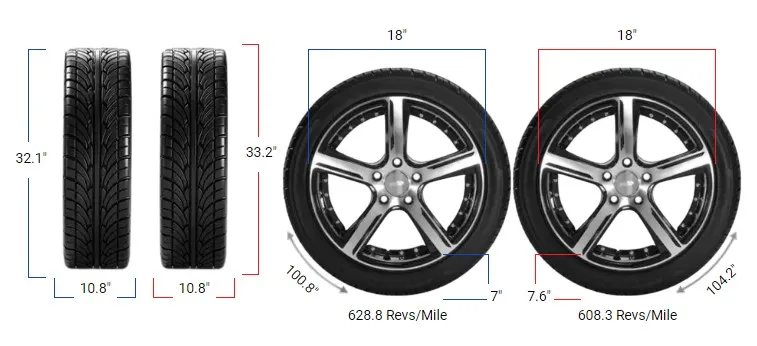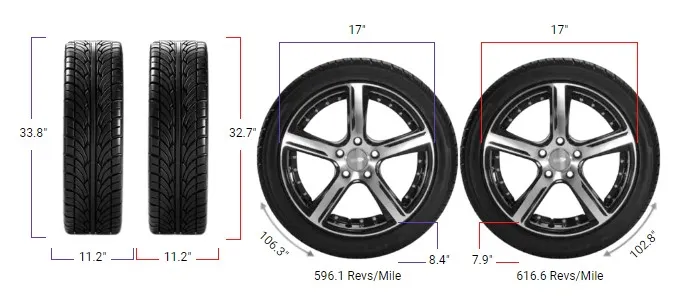Can I Use 185 Tires Instead of 165?

Yes. You can use 185 tires instead of 165 tires, but it’s essential to consider a few key factors to ensure compatibility and safety.
The Ideal Rim Width Range for both tire sizes must overlap, providing a stable foundation for performance, comfort, and safety.
Tire Compatibility
To determine if 185 tires can replace 165 tires, we first look at their respective ideal rim width ranges. The ideal rim width for 165 tires typically falls between 5.0 and 6.0 inches, while 185 tires require a rim width of 5.5 to 6.5 inches.
Since these ranges overlap (5.5 inches is common for both), this indicates that the 185 tires can indeed fit on the same rim as the 165 tires without compromising safety or performance.
Additionally, we must consider the overall diameter of the tires. If the aspect ratios and rim diameters differ, the overall diameter difference should not exceed 3%. In this case, both tire sizes are compatible, making the switch feasible.

On-Road Impact of Switching to 185 Tires
Switching to 185 tires can significantly affect your vehicle’s on-road performance. The wider tread of the 185 tires increases contact with the road, which enhances traction, especially in wet conditions.
Drivers often notice improved stability during cornering and better handling responsiveness. However, it’s essential to consider potential drawbacks. Wider tires may lead to increased rolling resistance, which can impact fuel efficiency.
Drivers may experience a slight decrease in ride comfort, as wider tires can transmit more road imperfections into the cabin. Overall, while on-road performance can improve, it’s crucial to balance these benefits against possible downsides.
Off-Road Impact of Switching to 185 Tires
When it comes to off-road performance, 185 tires can provide advantages due to their broader surface area, which allows for better weight distribution.
This results in improved traction on loose surfaces like mud and gravel. The added width can enhance stability on uneven terrains, reducing the likelihood of getting stuck.
However, wider tires may also have some disadvantages. In narrow trails or tight turns, they can be less maneuverable, making it challenging to navigate through obstacles.
Additionally, the increased width can lead to more tire drag, which may impact the vehicle’s overall performance in rugged conditions.

Important Factors for Tire Swapping
When considering a tire swap, several factors are essential for ensuring compatibility and safety. Besides the ideal rim width range, you should also check the following:
- Tire Load Capacity: Ensure that the new tires can handle the weight of your vehicle.
- Aspect Ratio: This affects ride comfort and handling; maintain a similar ratio to prevent issues.
- Tread Pattern: Consider how the tread design will affect your driving conditions, whether on-road or off-road.
- Speed Rating: Make sure the new tires meet or exceed the speed rating of the original tires.
By considering these factors, you can make a more informed decision about whether to switch to 185 tires.
Difference Between 165 and 185 Tires
The primary difference between 165 and 185 tires is their width, with 185 tires being 20mm wider than 165 tires.
This change in width impacts handling, stability, and the overall driving dynamics of your vehicle. Wider tires offer better grip, but narrower ones might improve fuel efficiency.
Can I Use 165 Tires Instead of 185?
Yes, you can use 165 tires instead of 185 tires. The ideal rim width range for 165 tires (5.5-6.0 inches) overlaps with the minimum rim width for 185 tires (5.5-6.5 inches). This ensures proper fitment.
However, you should also consider the aspect ratio and rim diameter of both tires. If these are not the same, the overall diameter difference must be within 3%, as exceeding this threshold can affect speedometer readings and vehicle performance.
Can I Use 185 Tires Instead of 165?
Yes, 185 tires can be used instead of 165 tires. The ideal rim width range for 185 tires (5.5-6.5 inches) overlaps with the ideal range for 165 tires (5.0-6.0 inches), making them compatible for use on the same rim.
Be cautious of the tire diameter—if the aspect ratio or rim diameter differs, ensure the overall diameter difference stays within 3% to maintain vehicle handling and speedometer accuracy.
Can You Put 165 Tires on 185 Rims?
Yes, you can put 165 tires on rims designed for 185 tires. The ideal rim width range for 185 tires (5.5-6.5 inches) overlaps with the ideal range for 165 tires (5.0-6.0 inches), allowing for safe fitment. However, using narrower tires on wider rims may affect handling and comfort.
Can You Put 185 Tires on 165 Rims?
Yes, 185 tires can be mounted on rims designed for 165 tires, as the ideal rim width range for 165 tires (5.0-6.0 inches) overlaps with the minimum rim width for 185 tires (5.5 inches).
However, using wider tires on narrower rims might impact handling, tire wear, and overall vehicle performance.
Our Observation
As a driver who recently made the switch from 165 to 185 tires, my experience has been largely positive. Initially, I was concerned about the ride comfort, but I quickly noticed improved handling and stability, especially during rainy conditions.
The wider tires gripped the road better, which boosted my confidence while driving. Off-road, the wider footprint helped me navigate through loose dirt and gravel, giving me the traction I needed without getting stuck.
However, I did find that in tighter trails, the wider tires required a bit more effort to maneuver around obstacles.
Overall, the switch has enhanced my driving experience, and I’d recommend considering this change for anyone looking to improve their vehicle’s performance.

Rifat Al Mahmud is the esteemed CTO of TireSizeCompare.com, an innovative online platform for tire size comparisons and information. With deep expertise in technology and development, Rifat leads his team in enhancing user experience and expanding the website’s capabilities, ensuring it remains a premier resource for drivers and automotive enthusiasts worldwide.


